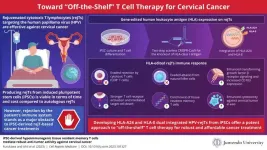(Press-News.org) Testing of illicit drugs bought online found 35% were not what they said they were, highlighting the urgent need for more local drug testing facilities in Australia to prevent harm and overdose.
The RMIT-led study analysed 103 illicit drug samples sourced from the now-defunct dark web forum Test4Pay in collaboration with the Australian National University, UNSW Sydney and Canadian testing facility Get Your Drugs Tested.
While 65% of samples contained only the advertised substance, the study found 14% of samples had a mixture of the advertised substance with other psychoactive or potentially harmful chemicals.
Meanwhile, 21% of samples did not contain any of the advertised substances.
MDMA, methamphetamines and heroin sourced were consistently found to only contain the advertised substance.
Products sold as ketamine, 2C-B and alprazolam were most likely to be completely substituted with other substances or new synthetic drugs, which increased the risk of unwanted side effects, potential overdose or death.
Of the 19 cocaine samples tested, only four were pure cocaine while 13 contained other substances and two samples did not contain any cocaine at all.
Lead researcher and RMIT Vice-Chancellor’s Senior Research Fellow, Dr Monica Barratt, said the results were concerning as drugs sold through cryptomarkets – online vendors on the dark web – were believed to be less likely to be mixed or substituted with other substances.
“Cryptomarkets allow anonymous buyers to review purchases, which theoretically means vendors who sell inferior products are more likely to receive bad reviews, thereby rewarding vendors selling superior products,” said Barratt, from RMIT’s Social Equity Research Centre.
“But despite this perception of accountability and quality, our findings show prohibited drugs purchased from cryptomarkets are still not safe from adulteration and substitution.”
The dark web drug market
According to the 2023 National Ecstasy and Related Drugs Reporting System survey, there was a slight decline of people buying drugs on the dark web, with more people turning to messaging and social media apps to source drugs.
“These apps are a lot more convenient and easier to use than the dark web, but they lack many of the security features and review capacities of darknet markets,” she said.
Barratt said Australia’s policies on tackling darknet markets focused on using law enforcement to ‘disrupt’ operations.
“These takedowns are used to create a sense of general deterrence through announcing arrests and interruptions to markets,” she said.
“However, we know through research on darknet market takedown operations that this ecosystem is quick to adapt to removal of markets.
“These days, vendors have accounts across many markets, in case one goes down, their clients can find them on other markets. This mitigates against the disruption of a takedown.”
Australia’s approach to drug regulation
With Australians finding new ways to source illicit drugs, Barratt said it was more urgent than ever to launch more drug checking services.
Currently, CanTEST is the only drug checking service available in Australia, with Queensland due to launch its own services this year and Victoria considering following suit.
“Drug checking is a precautionary and pragmatic response to the health risks of unpredictable drug markets, often detecting hazardous substances before they flood the local market,” she said.
While drug checking services have been operating around the world for over 50 years, Barratt said Australia remained resistant to expanding the harm reduction service.
“Australia’s resistance to opening more drug checking facilities stems from an assumption that drug checking ‘green lights’ drug use,” Barratt said.
“Drug checking services never tell consumers that their drugs are ‘safe’ as no drug use can be 100% safe.
“What the service can do is explain the known risks of specific drugs, in a credible and non judgemental way, enabling people who use drugs to adjust their behaviour to reduce risk.”
A 2022 systemic review of pill testing found people who found unexpected substances in their drugs were more likely to discard them and adjust their use.
“If we can prevent overdoses from happening in the first place, then we can not only reduce harm for consumers and avoid the pain felt by bereaved family members, but also ease the pressures on our emergency health system,” Barratt said.
“Adulteration and substitution of drugs purchased in Australia from cryptomarkets: An analysis of Test4Pay” was published in the Drug and Alcohol Review (DOI: 10.1111/dar.13825)
Monica J. Barratt, Matthew Ball, Gabriel T. W. Wong and Angus Quinton are co-authors.
END
More than 1/3 illicit drugs sold on the dark web contain unexpected substances
Testing of illicit drugs bought online found 35% were not what they said they were, highlighting the urgent need for more local drug testing facilities in Australia to prevent harm and overdose.
2024-03-04
ELSE PRESS RELEASES FROM THIS DATE:
A better way to deliver fetal therapy for serious genetic disorders
2024-03-04
In a discovery that opens the door to a less invasive way of treating some serious disorders before birth, UC San Francisco scientists have found that delivering medicine through amniotic fluid is as effective as delivering it to the fetal brain via cerebrospinal fluid. The experiment was done in mice with a genetic disorder called Angelman syndrome.
Treating genetic diseases like Angelman in utero could prevent serious symptoms that begin while the fetus is still developing. It’s also easier to access neurons in the fetal brain because the blood-brain barrier that normally acts as a filter ...
Researchers develop amphibian-inspired camouflage skin
2024-03-04
Inspired by amphibians such as the wood frog, investigators designed and synthesized a new type of camouflage skin involving one-dimensional photonic crystal structures assembled in three-dimensional flexible gels.
As described in Advanced Optical Materials, the camouflage skin can quickly recognize and match the background by modulating the optical signals of external stimuli. It demonstrated excellent mechanical performance, self-adaptive camouflage capabilities in response to complex surroundings, and long-term stability in real-world living environments. Bright structural color and mechanical flexibility were maintained even at temperatures as low as -80℃.
The advance ...
Network of quantum sensors boosts precision
2024-03-04
The quantum systems employed in quantum technologies, for example single atoms, are also very sensitive: any interaction with the environment can induce changes in the quantum system, leading to errors. However, this remarkable sensitivity of quantum systems to environmental factors actually represents a unique advantage. This sensitivity enables quantum sensors to surpass conventional sensors in precision, for example when measuring magnetic or gravitational fields.
Noise cancellation using correlation spectroscopy
The delicate quantum properties needed for sensing can be covered up ...
Robotic hip exoskeleton shows promise for helping stroke patients regain their stride
2024-03-04
Robotic Hip Exoskeleton Shows Promise for Helping Stroke Patients Regain Their Stride
A portable robotic device created by UMass Amherst researchers provides new avenue for making state-of-the-art gait rehabilitation methods more effective and accessible
AMHERST, Mass. – More than 80% of stroke survivors experience walking difficulty, significantly impacting their daily lives, independence, and overall quality of life. Now, new research from the University of Massachusetts Amherst pushes forward the bounds of stroke recovery ...
Conservation value of field research stations grossly misunderstood and underfunded according to 173 conservation scientists in new study
2024-03-04
SAN DIEGO – Funding of field conservation research stations worldwide has been drastically reduced since the beginning of the COVID-19 pandemic, raising the alarm of more than 170 conservation researchers representing 157 field stations in 56 countries in a new paper published in Conservation Letters. The authors contend that field research stations have a high return on investment and are essential and highly effective tools for biodiversity conservation.
Trillions of U.S. dollars were mobilized in economic recovery following the pandemic, yet the authors raise concerns ...
Study underscores social factors of low breast cancer screening in the US
2024-03-04
There is a pressing need to explore and understand which social determinants of health (SDOH) and health inequities act as significant influential factors that contribute to low breast cancer screening behaviors in the United States.
Health disparities have been consistently associated with delayed screening, which then contributes to higher mortality rates among both Hispanic and Black populations. Moreover, poverty, lack of education, neighborhood disadvantage, residential segregation, racial discrimination, lack of social support and social isolation ...
Nanomedicine research aims to transform treatment of aortic aneurysms
2024-03-04
Aortic aneurysms are bulges in the aorta, the largest blood vessel that carries oxygen-rich blood from the heart to the rest of the body. Smoking, high blood pressure, diabetes, or injury can all increase the risk of aneurysms, which tend to occur more often in Caucasian male smokers over the age of 65.
“The soft tissues that make up blood vessels act essentially like rubber bands, and it’s the elastic fibers within these tissues that allow them to stretch and snap back,” says Professor Anand Ramamurthi, chair of the Department of Bioengineering in Lehigh University’s P.C. Rossin College of Engineering ...
HIV medication can be used safely with gender-affirming hormone therapy
2024-03-04
New research definitively shows that HIV antiretrovirals can be taken together with gender-affirming hormone therapy without changing how well either drug works. The study findings can help healthcare providers address potential patient concerns that one drug will counteract the other.
“This study is the first head-to-head pharmacokinetic analysis of two common HIV medications and long-term feminizing hormone therapy use,” says Walter Kraft, MD, director of the Division of Clinical ...
Gene-edited lymphocytes and the path toward ‘off-the-shelf’ therapy against cervical cancer
2024-03-04
Cervical cancer is among the most common malignancies affecting women worldwide. In 2020 alone, approximately 600,000 women were diagnosed with this disease, and over 314,000 died from it. In 99% of the cases, cervical cancer cells harbor human papilloma virus (HPV), and thus, HPV vaccines are an effective way to mitigate the risk of developing this disease. Unfortunately, such preventive measures are useless against established cancers, which are generally incurable once they become metastatic or relapsing.
Fortunately, scientists have made substantial progress in developing a promising ...
Humans have driven the Earth’s freshwater cycle out of its stable state
2024-03-04
A new analysis of freshwater resources across the globe shows that human activity has pushed variation in the planet’s freshwater cycle well outside of its pre-industrial range. The study shows that the updated planetary boundary for freshwater change was surpassed by the mid-twentieth century. In other words, for the past century, humans have been pushing the Earth’s freshwater system far beyond the stable conditions that prevailed before industrialization.
This is the first time that global water cycle change has been assessed over such a long timescale with an appropriate reference baseline. The findings, published in Nature Water, show that human ...
LAST 30 PRESS RELEASES:
Numbers in our sights affect how we perceive space
SIMJ announces global collaborative book project in commemoration of its 75th anniversary
Air pollution exposure and birth weight
Obstructive sleep apnea risk and mental health conditions among older adults
How talking slows eye movements behind the wheel
The Ceramic Society of Japan’s Oxoate Ceramics Research Association launches new international book project
Heart-brain connection: international study reveals the role of the vagus nerve in keeping the heart young
Researchers identify Rb1 as a predictive biomarker for a new therapeutic strategy in some breast cancers
Survey reveals ethical gaps slowing AI adoption in pediatric surgery
Stimulant ADHD medications work differently than thought
AI overestimates how smart people are, according to HSE economists
HSE researchers create genome-wide map of quadruplexes
Scientists boost cell "powerhouses" to burn more calories
Automatic label checking: The missing step in making reliable medical AI
Low daily alcohol intake linked to 50% heightened mouth cancer risk in India
American Meteorological Society announces Rick Spinrad as 2026 President-Elect
Biomass-based carbon capture spotlighted in newly released global climate webinar recording
Illuminating invisible nano pollutants: advanced bioimaging tracks the full journey of emerging nanoscale contaminants in living systems
How does age affect recovery from spinal cord injury?
Novel AI tool offers prognosis for patients with head and neck cancer
Fathers’ microplastic exposure tied to their children’s metabolic problems
Research validates laboratory model for studying high-grade serous ovarian cancer
SIR 2026 delivers transformative breakthroughs in minimally invasive medicine to improve patient care
Stem Cell Reports most downloaded papers of 2025 highlight the breadth and impact of stem cell research
Oxford-led study estimates NHS spends around 3% of its primary and secondary care budget on the health impacts of heat and cold in England
A researcher’s long quest leads to a smart composite breakthrough
Urban wild bees act as “microbial sensors” of city health.
New study finds where you live affects recovery after a hip fracture
Forecasting the impact of fully automated vehicle adoption on US road traffic injuries
Alcohol-related hospitalizations from 2016 to 2022
[Press-News.org] More than 1/3 illicit drugs sold on the dark web contain unexpected substancesTesting of illicit drugs bought online found 35% were not what they said they were, highlighting the urgent need for more local drug testing facilities in Australia to prevent harm and overdose.




